Morteza Hashemi
Privacy-Preserving Quantized Federated Learning with Diverse Precision
Jul 01, 2025Abstract:Federated learning (FL) has emerged as a promising paradigm for distributed machine learning, enabling collaborative training of a global model across multiple local devices without requiring them to share raw data. Despite its advancements, FL is limited by factors such as: (i) privacy risks arising from the unprotected transmission of local model updates to the fusion center (FC) and (ii) decreased learning utility caused by heterogeneity in model quantization resolution across participating devices. Prior work typically addresses only one of these challenges because maintaining learning utility under both privacy risks and quantization heterogeneity is a non-trivial task. In this paper, our aim is therefore to improve the learning utility of a privacy-preserving FL that allows clusters of devices with different quantization resolutions to participate in each FL round. Specifically, we introduce a novel stochastic quantizer (SQ) that is designed to simultaneously achieve differential privacy (DP) and minimum quantization error. Notably, the proposed SQ guarantees bounded distortion, unlike other DP approaches. To address quantization heterogeneity, we introduce a cluster size optimization technique combined with a linear fusion approach to enhance model aggregation accuracy. Numerical simulations validate the benefits of our approach in terms of privacy protection and learning utility compared to the conventional LaplaceSQ-FL algorithm.
Optimizing NOMA Transmissions to Advance Federated Learning in Vehicular Networks
Aug 06, 2024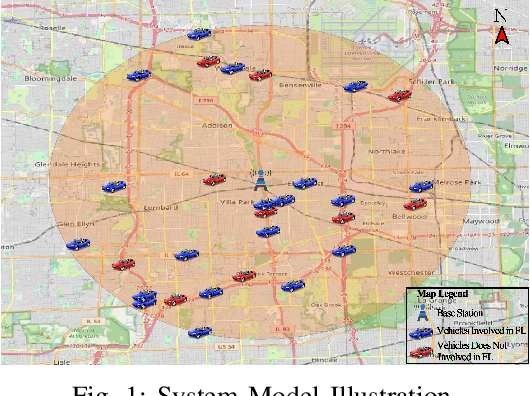
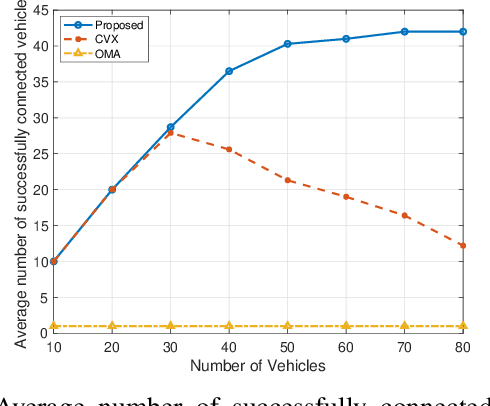
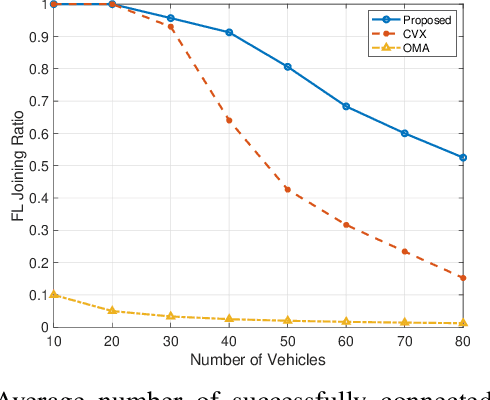

Abstract:Diverse critical data, such as location information and driving patterns, can be collected by IoT devices in vehicular networks to improve driving experiences and road safety. However, drivers are often reluctant to share their data due to privacy concerns. The Federated Vehicular Network (FVN) is a promising technology that tackles these concerns by transmitting model parameters instead of raw data, thereby protecting the privacy of drivers. Nevertheless, the performance of Federated Learning (FL) in a vehicular network depends on the joining ratio, which is restricted by the limited available wireless resources. To address these challenges, this paper proposes to apply Non-Orthogonal Multiple Access (NOMA) to improve the joining ratio in a FVN. Specifically, a vehicle selection and transmission power control algorithm is developed to exploit the power domain differences in the received signal to ensure the maximum number of vehicles capable of joining the FVN. Our simulation results demonstrate that the proposed NOMA-based strategy increases the joining ratio and significantly enhances the performance of the FVN.
Multi-Task Decision-Making for Multi-User 360 Video Processing over Wireless Networks
Jul 03, 2024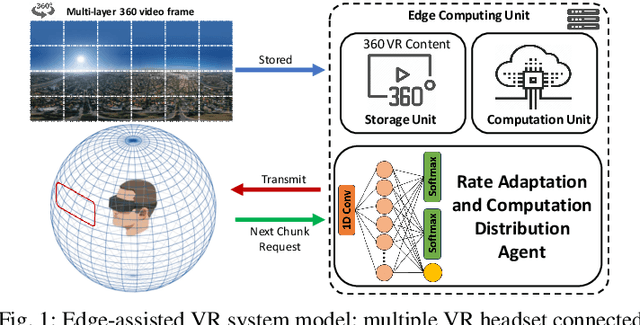
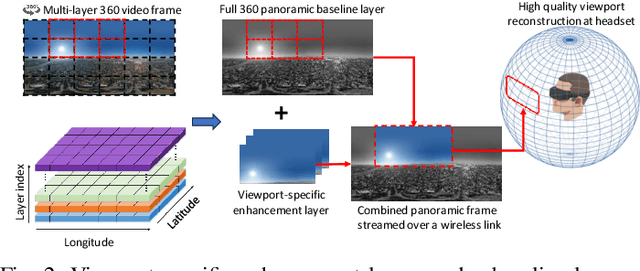
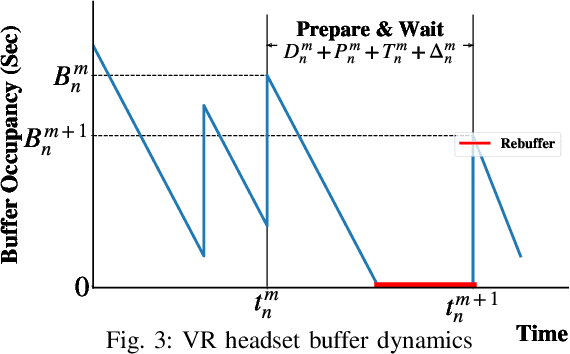
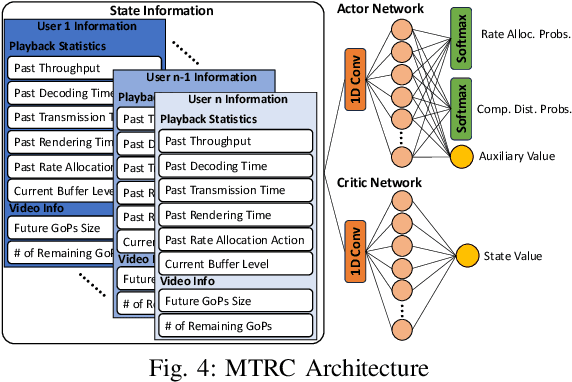
Abstract:We study a multi-task decision-making problem for 360 video processing in a wireless multi-user virtual reality (VR) system that includes an edge computing unit (ECU) to deliver 360 videos to VR users and offer computing assistance for decoding/rendering of video frames. However, this comes at the expense of increased data volume and required bandwidth. To balance this trade-off, we formulate a constrained quality of experience (QoE) maximization problem in which the rebuffering time and quality variation between video frames are bounded by user and video requirements. To solve the formulated multi-user QoE maximization, we leverage deep reinforcement learning (DRL) for multi-task rate adaptation and computation distribution (MTRC). The proposed MTRC approach does not rely on any predefined assumption about the environment and relies on video playback statistics (i.e., past throughput, decoding time, transmission time, etc.), video information, and the resulting performance to adjust the video bitrate and computation distribution. We train MTRC with real-world wireless network traces and 360 video datasets to obtain evaluation results in terms of the average QoE, peak signal-to-noise ratio (PSNR), rebuffering time, and quality variation. Our results indicate that the MTRC improves the users' QoE compared to state-of-the-art rate adaptation algorithm. Specifically, we show a 5.97 dB to 6.44 dB improvement in PSNR, a 1.66X to 4.23X improvement in rebuffering time, and a 4.21 dB to 4.35 dB improvement in quality variation.
Federated Learning-based Collaborative Wideband Spectrum Sensing and Scheduling for UAVs in UTM Systems
Jun 03, 2024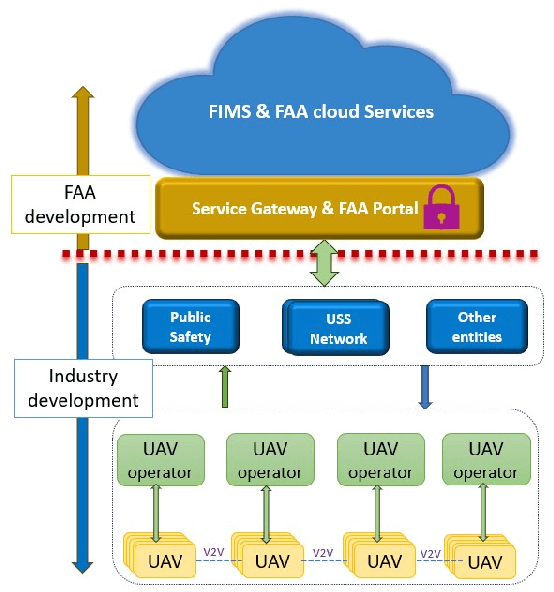
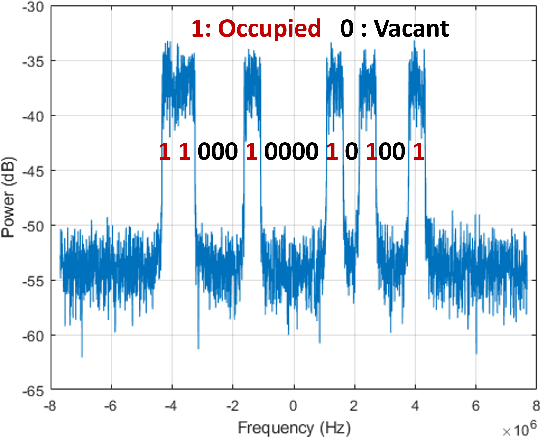


Abstract:In this paper, we propose a data-driven framework for collaborative wideband spectrum sensing and scheduling for networked unmanned aerial vehicles (UAVs), which act as the secondary users (SUs) to opportunistically utilize detected "spectrum holes". Our overall framework consists of three main stages. Firstly, in the model training stage, we explore dataset generation in a multi-cell environment and training a machine learning (ML) model using the federated learning (FL) architecture. Unlike the existing studies on FL for wireless that presume datasets are readily available for training, we propose a novel architecture that directly integrates wireless dataset generation, which involves capturing I/Q samples from over-the-air signals in a multi-cell environment, into the FL training process. Secondly, in the collaborative spectrum inference stage, we propose a collaborative spectrum fusion strategy that is compatible with the unmanned aircraft system traffic management (UTM) ecosystem. Finally, in the spectrum scheduling stage, we leverage reinforcement learning (RL) solutions to dynamically allocate the detected spectrum holes to the secondary users. To evaluate the proposed methods, we establish a comprehensive simulation framework that generates a near-realistic synthetic dataset using MATLAB LTE toolbox by incorporating base-station~(BS) locations in a chosen area of interest, performing ray-tracing, and emulating the primary users channel usage in terms of I/Q samples. This evaluation methodology provides a flexible framework to generate large spectrum datasets that could be used for developing ML/AI-based spectrum management solutions for aerial devices.
Centralized vs. Decentralized Multi-Agent Reinforcement Learning for Enhanced Control of Electric Vehicle Charging Networks
Apr 18, 2024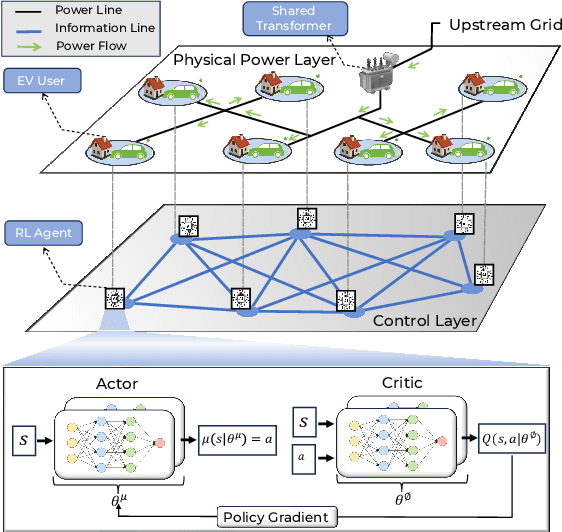

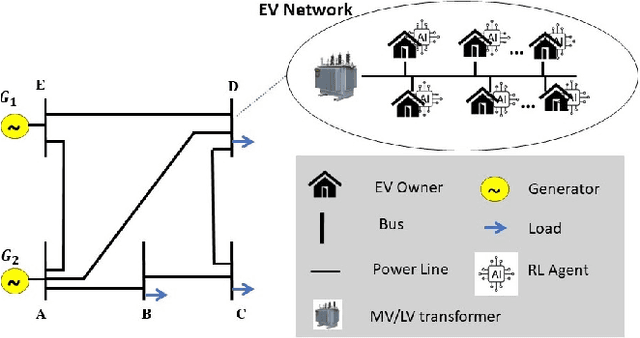

Abstract:The widespread adoption of electric vehicles (EVs) poses several challenges to power distribution networks and smart grid infrastructure due to the possibility of significantly increasing electricity demands, especially during peak hours. Furthermore, when EVs participate in demand-side management programs, charging expenses can be reduced by using optimal charging control policies that fully utilize real-time pricing schemes. However, devising optimal charging methods and control strategies for EVs is challenging due to various stochastic and uncertain environmental factors. Currently, most EV charging controllers operate based on a centralized model. In this paper, we introduce a novel approach for distributed and cooperative charging strategy using a Multi-Agent Reinforcement Learning (MARL) framework. Our method is built upon the Deep Deterministic Policy Gradient (DDPG) algorithm for a group of EVs in a residential community, where all EVs are connected to a shared transformer. This method, referred to as CTDE-DDPG, adopts a Centralized Training Decentralized Execution (CTDE) approach to establish cooperation between agents during the training phase, while ensuring a distributed and privacy-preserving operation during execution. We theoretically examine the performance of centralized and decentralized critics for the DDPG-based MARL implementation and demonstrate their trade-offs. Furthermore, we numerically explore the efficiency, scalability, and performance of centralized and decentralized critics. Our theoretical and numerical results indicate that, despite higher policy gradient variances and training complexity, the CTDE-DDPG framework significantly improves charging efficiency by reducing total variation by approximately %36 and charging cost by around %9.1 on average...
Semantic-Aware and Goal-Oriented Communications for Object Detection in Wireless End-to-End Image Transmission
Feb 01, 2024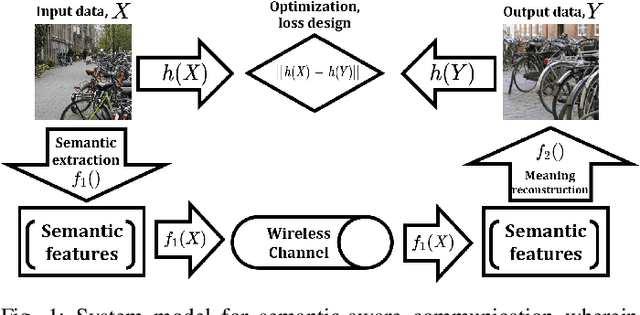
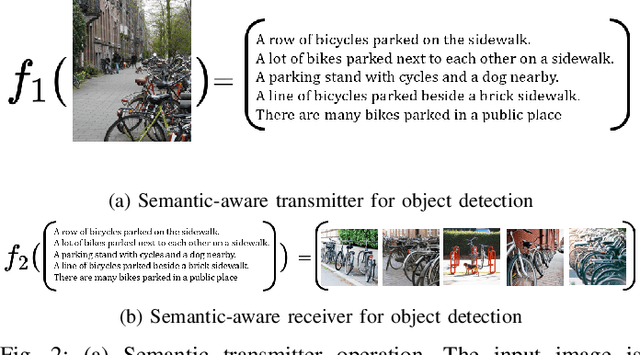
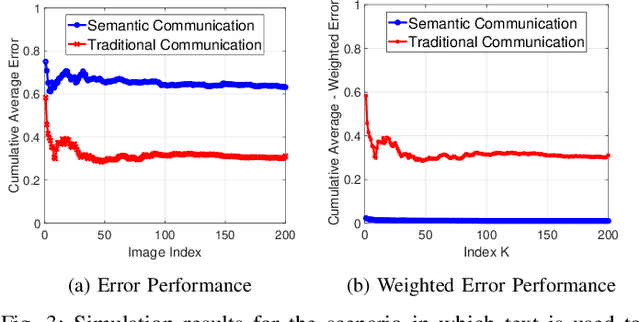
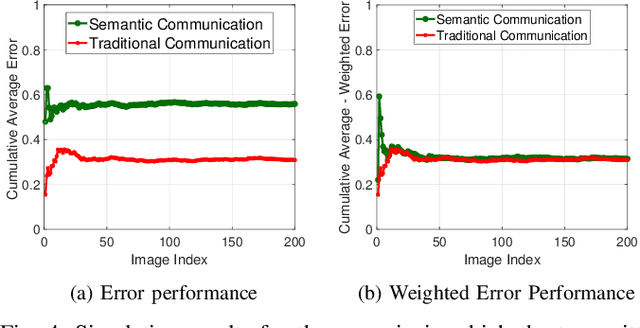
Abstract:Semantic communication is focused on optimizing the exchange of information by transmitting only the most relevant data required to convey the intended message to the receiver and achieve the desired communication goal. For example, if we consider images as the information and the goal of the communication is object detection at the receiver side, the semantic of information would be the objects in each image. Therefore, by only transferring the semantics of images we can achieve the communication goal. In this paper, we propose a design framework for implementing semantic-aware and goal-oriented communication of images. To achieve this, we first define the baseline problem as a set of mathematical problems that can be optimized to improve the efficiency and effectiveness of the communication system. We consider two scenarios in which either the data rate or the error at the receiver is the limiting constraint. Our proposed system model and solution is inspired by the concept of auto-encoders, where the encoder and the decoder are respectively implemented at the transmitter and receiver to extract semantic information for specific object detection goals. Our numerical results validate the proposed design framework to achieve low error or near-optimal in a goal-oriented communication system while reducing the amount of data transfers.
Efficient Cluster Selection for Personalized Federated Learning: A Multi-Armed Bandit Approach
Oct 29, 2023Abstract:Federated learning (FL) offers a decentralized training approach for machine learning models, prioritizing data privacy. However, the inherent heterogeneity in FL networks, arising from variations in data distribution, size, and device capabilities, poses challenges in user federation. Recognizing this, Personalized Federated Learning (PFL) emphasizes tailoring learning processes to individual data profiles. In this paper, we address the complexity of clustering users in PFL, especially in dynamic networks, by introducing a dynamic Upper Confidence Bound (dUCB) algorithm inspired by the multi-armed bandit (MAB) approach. The dUCB algorithm ensures that new users can effectively find the best cluster for their data distribution by balancing exploration and exploitation. The performance of our algorithm is evaluated in various cases, showing its effectiveness in handling dynamic federated learning scenarios.
An Efficient Distributed Multi-Agent Reinforcement Learning for EV Charging Network Control
Aug 24, 2023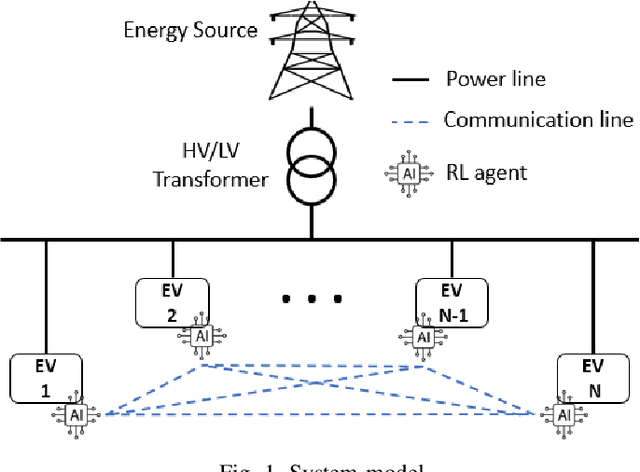
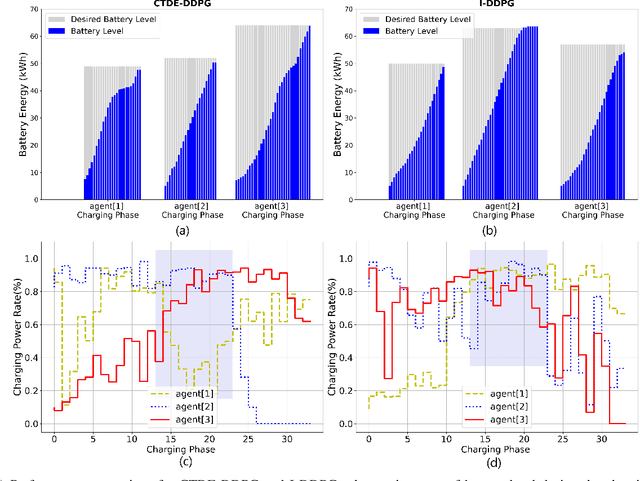
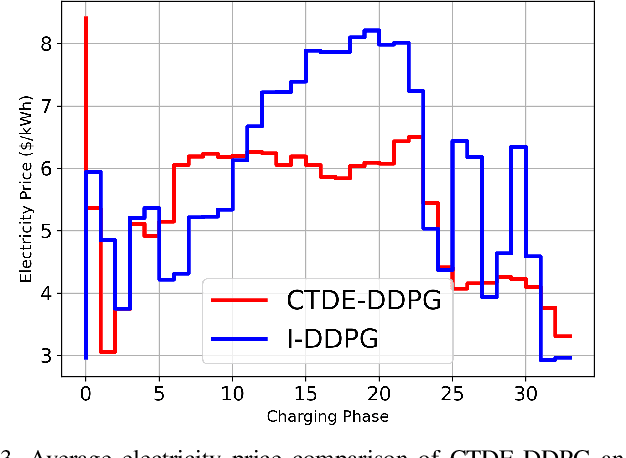

Abstract:The increasing trend in adopting electric vehicles (EVs) will significantly impact the residential electricity demand, which results in an increased risk of transformer overload in the distribution grid. To mitigate such risks, there are urgent needs to develop effective EV charging controllers. Currently, the majority of the EV charge controllers are based on a centralized approach for managing individual EVs or a group of EVs. In this paper, we introduce a decentralized Multi-agent Reinforcement Learning (MARL) charging framework that prioritizes the preservation of privacy for EV owners. We employ the Centralized Training Decentralized Execution-Deep Deterministic Policy Gradient (CTDE-DDPG) scheme, which provides valuable information to users during training while maintaining privacy during execution. Our results demonstrate that the CTDE framework improves the performance of the charging network by reducing the network costs. Moreover, we show that the Peak-to-Average Ratio (PAR) of the total demand is reduced, which, in turn, reduces the risk of transformer overload during the peak hours.
Exploring the Interplay of Interference and Queues in Unlicensed Spectrum Bands for UAV Networks
Aug 09, 2023Abstract:In this paper, we present an analytical framework to explore the interplay of signal interference and transmission queue management, and their impacts on the performance of unmanned aerial vehicles (UAVs) when operating in the unlicensed spectrum bands. In particular, we develop a comprehensive framework to investigate the impact of other interference links on the UAV as it communicates with the ground users. To this end, we provide closed-form expressions for packet drop probabilities in the queue due to buffer overflow or large queuing delay, which are expressed in terms of a transmission policy as a function of the channel fading threshold $\beta$. The overall packet loss caused either by interference signals or queuing packet drop is obtained, which, in turn, yields in obtaining the expected throughput performance. Through extensive numerical results, we investigate the impact of the channel fading threshold $\beta$, which plays an important role in balancing the trade-offs between packet loss due to queue drop or transmission error due to large interference levels.
Collaborative Wideband Spectrum Sensing and Scheduling for Networked UAVs in UTM Systems
Aug 09, 2023

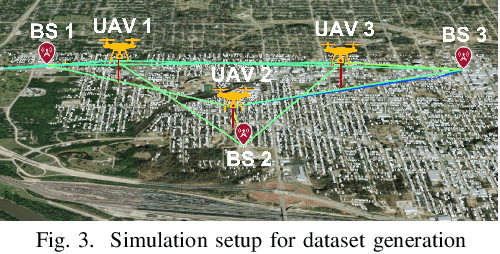
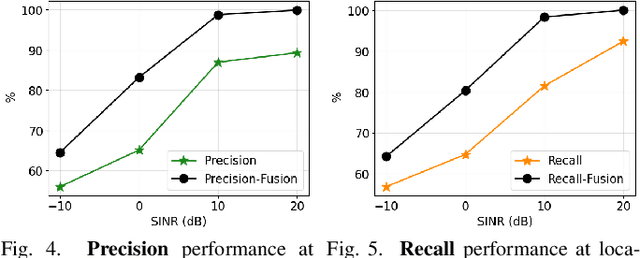
Abstract:In this paper, we propose a data-driven framework for collaborative wideband spectrum sensing and scheduling for networked unmanned aerial vehicles (UAVs), which act as the secondary users to opportunistically utilize detected spectrum holes. To this end, we propose a multi-class classification problem for wideband spectrum sensing to detect vacant spectrum spots based on collected I/Q samples. To enhance the accuracy of the spectrum sensing module, the outputs from the multi-class classification by each individual UAV are fused at a server in the unmanned aircraft system traffic management (UTM) ecosystem. In the spectrum scheduling phase, we leverage reinforcement learning (RL) solutions to dynamically allocate the detected spectrum holes to the secondary users (i.e., UAVs). To evaluate the proposed methods, we establish a comprehensive simulation framework that generates a near-realistic synthetic dataset using MATLAB LTE toolbox by incorporating base-station~(BS) locations in a chosen area of interest, performing ray-tracing, and emulating the primary users channel usage in terms of I/Q samples. This evaluation methodology provides a flexible framework to generate large spectrum datasets that could be used for developing ML/AI-based spectrum management solutions for aerial devices.
 Add to Chrome
Add to Chrome Add to Firefox
Add to Firefox Add to Edge
Add to Edge